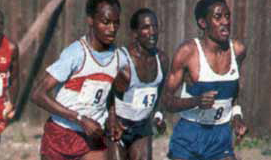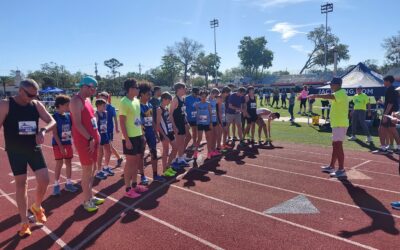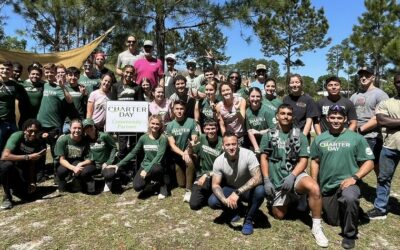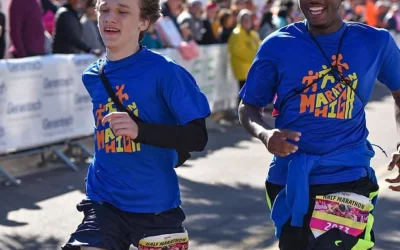 Vol. 37, No.1, issue 384 – Jan/Feb 2011
Vol. 37, No.1, issue 384 – Jan/Feb 2011
By Richard Fannin
Below is a paper I wrote for an English class in college (in 1990):
The first think I noticed about Gidamis Shahanga was the huge space between his two front teeth.
He was born in Tanzania – in the town of Katesh – at about 5,700 feet altitude. My assumption is that good dentists are hard to come by in Katesh. Also startling to me was his frail stature. Thanks to Track and Field News magazine, I have since determined that he is 5’11” and 126 pounds.
It was at the Jacksonville International Airport where I first laid eyes on Shahanga. He, as a student (and runner) at the University of Texas at El Paso – was flying in for the River Run. The River Run, a world-class 15 kilometer road race held in Jacksonville each year, in past years had attracted top Americans (such as Bill Rodgers) but this was 1984, and the Africans now dominated road running.
Getting Shahanga to run here was a coup of sorts. He was arguably running as well as anyone in the world – and was a heavy favorite to won an Olympic Medal that summer. Two years earlier – in 1982 – as a freshman at UTEP, Gidamis ran a 27:38 for 10,000 meters on the track. Amazingly, although he ran the 3rd fastest collegiate 10,000 meters of all time in that race, he placed third in that race – beaten by two of his teammates – Gabriel Kamau and Zack Barie. Barie had also won the 1983 NCAA Cross-Country individual championship in 1983.
Barie was also in Jacksonville, and the stage was set for a showdown between the two good friends and phenomenal talents from Tanzania. Also figuring in the mix should be Joseph Nzau, a Kenyan who had been tearing up the roads in 1984. No slouch, Nzau also had a sub-28:00 10,000 meter PR to his credit. Nzau was also a six-time All-American runner from the University of Wyoming. Nzau was quite a character and was known to wear his wool ski cap everywhere (even in warm weather). He also was a notorious womanizer. He was coming off a win in the Chicago Marathon the prior fall, which he ran in 2:09:44. It was the first major US marathon win ever by an African. Shahanga for some reason) did not want to stay in a hotel, so my father (who was coordinating the elite runners for the race) offered for him to stay at our home. He got the guest bedroom – and his own TV – which he requested. Although he had lived in America for 3 years, he still spoke broken English, and was quite shy.
His coach at UTEP, Ted Banks, was quite the controversial character in the running world. He was accused of “buying NCAA championships” by heavily recruiting African runners to run for his squad. And win championships he did … in his tenure at the University (from 1972-1981) Banks won 17 NCAA team championships in cross country and track and field; and produced 47 individual NCAA champions.
His 1981 cross-country team (which included Shahanga and Zack Barie) won with a near-perfect score of 17 – the lowest ever in the history of the championships.
Shahanga had also placed 15th in the Olympic Marathon in Moscow – at the age of 23.
When I asked Shahanga about Banks, he rushed to defend his coach. “Ted is a wonderful man. If it were not for him, my family would still be poor, I would be uneducated, and I never would have reached my potential in running”
Sometimes I couldn’t tell if Shahanga was being cocky; or just innocent and straightforward. He calmly told me the night before the race that he would win – and probably set the world record.
The morning of the race, I awoke feeling like an expectant father. Although I had only known Shahanga for a couple of days, I couldn’t wait to watch the race and pull for him.
I was right in the middle of track season in high school, and our coach would not let us run the race, but I had managed to get a pass onto the lead vehicle. It was exhilarating seeing 6,000 runners lined up next to the Gator Bowl. Just before the cannon fired, I realized that of the 6,000 runners, only 3 had a real chance to win – and they were all African.
It was a beautiful spring day – but warm – and I noticed the sun quickly reflecting off of the sweaty brows of the front runners. As the runners headed over the Main Street Bridge and began to snake onto the narrow streets of San Marco – the three favorites were right there; Shahanga, Barie and Nzau – all exchanging leads and clipping off 4:30 miles.
I did notice that the two Tanzanians – Shahanga and Barie – were sharing water cups at the aid stations leaving Nzau (the Kenyan) to fend for himself. No question there was a little country rivalry with these guys. There were some assorted Americans and a couple of British runners hanging around, but there was absolutely no question who the “big three” were.
As they passed through 10,000 meters (in 28:40) – Shahanga decided to throw the hammer down. I guess he wanted to break the other two before they got to the Hart Bridge, a colossal green truss bridge that hovers over the race – and the Jacksonville skyline. Locals have affectionately dubbed it “The Green Monster”Barie and Nzau expected the move, sensed the move, and covered the move. The three men quickly and decisively separated from the pretenders and started up the bridge. Shahanga and Barie ran side by side – and Nzau was positioned directly behind them – like a vulture.
By the crest of the bridge, Shahanga was tired of playing games and found his final gear. He set a blistering pace on the down ramp, and left Barie and Nzau hapless in his wake.
Shahanga flew down the final straight, breaking the tape in 42:54 – a new course record, and the second fastest 15k ever run. Someone on the truck said they timed his final (downhill) mile in 4:04.
Nzau – 10 seconds behind Shahanga – ended up nipping Barie for 2nd with a 43:04. Barie came home in 43:07. To this day – 27 years later – those are still 3 of the 7 fastest times ever run in the race. It was the only time 3 men have ever run under 43:10 in the Gate River Run. In 4th place and first American – was Mark Stickley – an unheralded junior at Virginia Tech (who was in Florida for spring break). Stickley had a horribly sun-burned face and body from his week at Daytona Beach – yet came home in 43:19. Stickley had some nice races in the future, but never duplicated his performance that day.
At the awards ceremony, Shahanga, Barie and Stickley all had to be reminded that they could not accept any prize money, due to their status as current NCAA athletes.
Nzau – who was offered (and accepted) his prize money – was pounding beers, chasing women, and dancing to the band before the awards ceremony – with his trademark ski cap on – despite temperatures in the 80s.
Those were the days.
Author’s post-script
• Shahanga ran poorly in the Olympic Marathon that summer in Los Angeles – placing 22nd. He also ran in the 10,000 meters – but was eliminated in the heats. Shahanga’s last major victory was a win in the Vienna Marathon in 1990 – with a PR of 2:09:28.
• Nzau finished 14th in the 10,000 meters in the 1984 Olympics – and 7th in the marathon a week later. After winning the inaugural Belgrade marathon in 1990, he retired – to chase women full-time.
• Barie finished 15th in the 5,000 meters and 13th in the 10,000 meters in the 1984 Olympics. Arguably, all three men were at the absolute “peak of their powers” in 1984.





